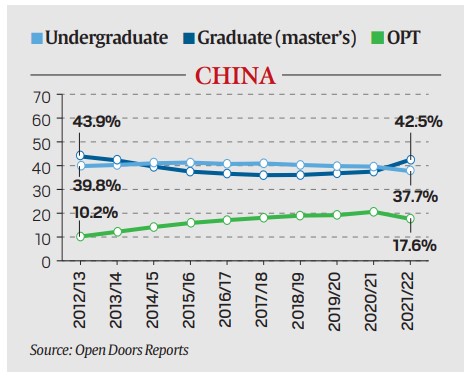Part 1: Steady rise in Indian students staying on for job training in US
More than Chinese; 12.8% in 2006-07 to 43.9% in 2020-21, more sign up for scheme that lets them work up to three years.
 In comparison, just 17.6 per cent of the 2.9 lakh students of Chinese origin in the US have opted for these OPT programmes in 2021-22. (Representational/File)
In comparison, just 17.6 per cent of the 2.9 lakh students of Chinese origin in the US have opted for these OPT programmes in 2021-22. (Representational/File) As the government tries to make it easier for foreign campuses to set up operations in India in a bid to arrest the flow of Indian students — and their funds — overseas, one trend poses a distinct challenge: the increasing lure of US work experience beyond the campus.
More and more Indian students studying in the US are choosing to stay back after their degree to join a three-year work or training programme, shows an analysis by The Indian Express of Open Doors data compiled by the US State Department and the non-profit Institute of International Education (IEE).

Data based on surveys of international exchange activity show that of the 1.99 lakh Indian students pursuing education in the US in 2021-22, as high a share as 34.2 per cent were enrolled with Optional Practical Training (OPT) programmes that allow foreign graduates with F-1 (student visa) to join paid or voluntary work up to three years in the US (see chart).
In comparison, just 17.6 per cent of the 2.9 lakh students of Chinese origin in the US have opted for these OPT programmes in 2021-22.
In the case of Indian students, this is a steady uptick: the percentage opting for OPT programmes has been increasing over the years, from just 12.8 per cent in 2006-07 to a peak of 43.9 per cent in 2020-21. For Chinese students, this share has remained relatively flat: from 10.6 per cent in 2006-07 to just 17.6 per cent in 2021-22.

Incidentally, India and China account for 52 per cent of all international students in the US.
OPT is a popular option for international students in the US to gain practical training experience while pursuing studies, or after graduating. While its duration is one year in most cases, for certain STEM (Science, Technology, Engineering, Mathematics) disciplines, it can extend up to three years.
The programme faced legal challenges from workers’ unions in the US which argued that it goes beyond the scope of student visas, but the US Court of Appeals DC circuit upheld its validity in October last year.
Students commonly transition from OPT authorisation (part of F-1 status) to H-1B status. OPT is seen, in many cases, as a stepping stone to an H1-B visa for foreign graduates, especially in STEM fields. Overall, in 2021-22, Indian students made up roughly 37 per cent of the 1,84,759 international students in the US signing up for OPT.
The Open Doors data also show that fewer share of Indians are picking postgraduate degrees in the US – from a high of 79 per cent in 2003-04 to 51.2 per cent in 2021-22. China has also registered a dip — from 82.2 per cent in 2003-04 to 42.5 per cent in 2021-22.
But when it comes to undergraduate studies, students of Chinese origin in the US have risen from 13.8 per cent in 2000-01 to 37.7 per cent in 2021-22, while the numbers have fallen from 22.4 per cent to 13.8 per cent in India’s case.
In absolute numbers, 1,99,182 students from India were pursuing education in the US in 2021-22, as against 1,67,582 in 2020-21 — a 19 per cent increase. China, meanwhile, registered a drop of 9 per cent in the latest round — from 3,17,299 in 2020-21 to 2,90,086 in 2021-22. This was largely attributed to Covid and the restrictive rules that Beijing put in place which were eased only last month.
In a recent report, the Organisation for Economic Co-operation and Development (OECD) pointed out that among foreign-origin students pursuing higher education in some of the most developed economies in the world, Indians are most likely to stay back and join the local workforce.
“Students from China and India, the two largest groups of international students in the OECD, show remarkably different retention behaviours.
Indian students tend to have a higher stay rate than the overall international student population.
The retention behaviour of Chinese students is more diverse, with overall larger shares leaving after their education,” states the report titled ‘International Migration Outlook 2022’.
- 01
- 02
- 03
- 04
- 05































